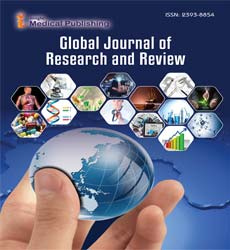ISSN : 2393-8854
Global Journal of Research and Review
Molecular Insights into Protein Misfolding Disorders
Enea Albina*
Department of Molecular Biology, University Hospital Geneva, 1211 Geneva, Switzerland
*Corresponding author:
Enea Albina,
Department of Molecular Biology, University Hospital Geneva, 1211 Geneva, Switzerland,
E-mail: juanfernando.iglesias@hug.ch
Received date: February 03, 2025, Manuscript No. ipgjrr-25-20641; Editor assigned date: February 05, 2025, PreQC No ipgjrr-25-20641(PQ); Reviewed date: February 10, 2025, QC No. ipgjrr-25-20641; Revised date: February 17, 2025, Manuscript No. ipgjrr-25-20641 (R); Published date: February 24, 2025, DOI: 10.36648/2393-8854.12.1.05
Citation: Albina E (2025) Molecular Insights into Protein Misfolding Disorders. Glob J Res Rev.12.1.05
Introduction
Proteins are essential macromolecules that perform a vast array of biological functions, from catalyzing metabolic reactions to providing structural support and transmitting signals within and between cells. To carry out their roles, proteins must adopt precise three-dimensional conformations dictated by their amino acid sequences. However, this intricate process of protein folding is not infallible. When proteins misfold, they may lose their functional properties or adopt aberrant structures that can accumulate and interfere with normal cellular processes. Such misfolded proteins are implicated in a broad spectrum of human diseases, collectively known as protein misfolding disorders. These include neurodegenerative conditions such as Alzheimerâ??s disease, Parkinsonâ??s disease, Huntingtonâ??s disease and Amyotrophic Lateral Sclerosis (ALS), as well as systemic amyloidoses and prion diseases. Understanding the molecular mechanisms of protein misfolding has become a central focus in biomedical research, as it provides not only insights into disease pathogenesis but also avenues for therapeutic intervention [1].
Description
Protein folding is a finely regulated process that ensures polypeptide chains reach their correct native conformation. This process often requires the assistance of molecular chaperones, which stabilize intermediate states and prevent aggregation. Under normal conditions, misfolded proteins are recognized and degraded by quality control systems such as the ubiquitin-proteasome pathway and autophagy.
However, when these surveillance systems are overwhelmed or defective, misfolded proteins can accumulate, leading to toxic effects. At the molecular level, protein misfolding disorders are often characterized by the formation of aggregates rich in β-sheet structures. These aggregates can assemble into insoluble fibrils known as amyloids, which are a pathological hallmark of many neurodegenerative diseases. For example, in Alzheimerâ??s disease, the misfolding of amyloid-β peptides leads to extracellular plaque deposition, while tau protein misfolding results in intracellular neurofibrillary tangles. Together, these aggregates disrupt synaptic function, impair neuronal communication and trigger cell death. In Parkinsonâ??s disease, the misfolding of α-synuclein produces Lewy bodies that interfere with dopaminergic signaling. Similarly, Huntingtonâ??s disease is marked by the aggregation of huntingtin protein with expanded polyglutamine repeats, causing neuronal toxicity in the striatum [2].
Prion diseases represent a unique category of protein misfolding disorders where the misfolded protein itself acts as an infectious agent. The Pathogenic Prion Protein (PrP^Sc) induces conformational changes in the normal cellular Prion Protein (PrP^C), propagating a cycle of misfolding and aggregation. Unlike other protein misfolding diseases, prion disorders such as Creutzfeldtâ??Jakob disease and kuru can be transmitted between individuals and even across species, highlighting the remarkable stability of misfolded prion structures [1]. Protein misfolding is not restricted to the nervous system. Systemic amyloidoses involve the deposition of amyloid fibrils in organs such as the heart, kidneys and liver, leading to progressive organ failure. In type II diabetes, misfolding of islet amyloid polypeptide contributes to β-cell dysfunction and impaired insulin secretion. These examples underscore the widespread relevance of protein misfolding in human pathology.Mutations in chromatin remodeling complexes, such as those seen in Coffinâ??Siris syndrome or certain pediatric cancers, highlight their importance in both development and disease. Non-coding RNAs, including MicroRNAs (miRNAs) and Long Non-Coding RNAs (lncRNAs), provide yet another layer of epigenetic regulation. These molecules can modulate gene expression post-transcriptionally or recruit chromatin modifiers to specific genomic loci. In development, non-coding RNAs help fine-tune gene networks that guide differentiation and tissue morphogenesis. In disease contexts, aberrant expression of miRNAs has been associated with tumor progression, immune dysregulation and metabolic imbalance. For example, oncogenic miRNAs can silence tumor suppressor pathways, while loss of tumor-suppressive miRNAs contributes to unchecked proliferation [2].
Conclusion
Protein misfolding disorders represent a major challenge in modern medicine, affecting millions of people worldwide and posing significant social and economic burdens. At the molecular level, these conditions arise from failures in protein folding and quality control, leading to toxic aggregates that disrupt cellular function. Advances in structural biology, genetics and biochemistry have greatly expanded our understanding of the mechanisms underlying misfolding and aggregation, providing critical insights into disease progression. Importantly, this knowledge is fueling the development of innovative diagnostics and therapies aimed at preventing or reversing protein While many obstacles remain, particularly in translating experimental findings into effective treatments, the growing molecular understanding of protein misfolding disorders offers hope for the future. As research continues to uncover the intricate details ofprotein folding pathways, oligomer toxicity and proteostasis networks, new opportunities will emerge to intervene in these devastating diseases, ultimately improving patient outcomes and transforming our approach to neurodegenerative and systemic disorders alike.
Acknowledgement
None.
Conflict of Interest
None.
References
- Warman JM, DeHaas MP, Pichat P, Serpone N (1991) Effect of isopropyl alcohol on the surface localization and recombination of conduction-band electrons in Degussa P-25 Tio2. A pulse-radiolysis time-resolved microwave conductivity study. J Phys Chem 95(22): 8858-8861.
- Epling GA, Lin C (2002) Investigation of retardation effects on the titanium dioxide photodegradation system. Chemosphere 46(6): 937-944.
Open Access Journals
- Aquaculture & Veterinary Science
- Chemistry & Chemical Sciences
- Clinical Sciences
- Engineering
- General Science
- Genetics & Molecular Biology
- Health Care & Nursing
- Immunology & Microbiology
- Materials Science
- Mathematics & Physics
- Medical Sciences
- Neurology & Psychiatry
- Oncology & Cancer Science
- Pharmaceutical Sciences
